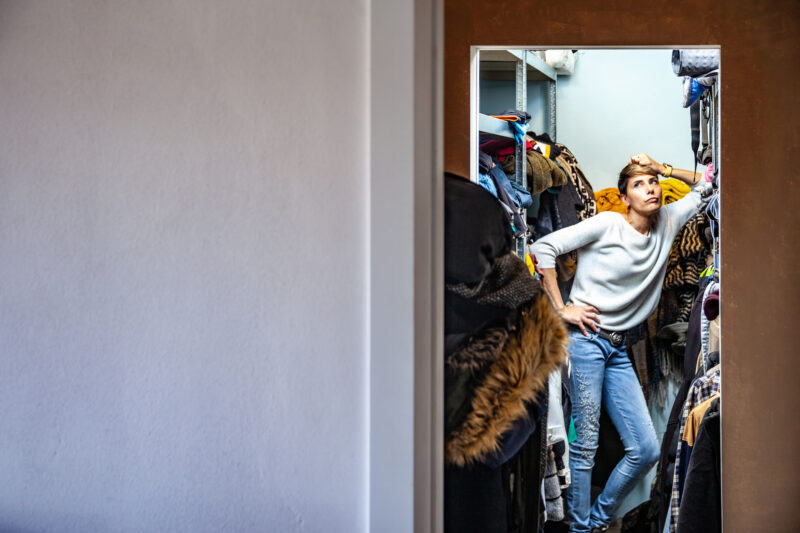
What Are the Five Levels of Hoarding?
4 min.
To better assess the severity of a hoarding situation, professionals use the Clutter–Hoarding Scale, which classifies hoarding into five levels.
Compulsive hoarding is more than just excessive clutter—it is a mental health condition that can severely impact a person’s well-being and their ability to maintain a functional living space. Hoarding disorder is characterized by persistent difficulty in discarding possessions, leading to severe clutter, blocked pathways, and, in extreme cases, unsanitary conditions.
To better assess the severity of a hoarding situation, professionals use the Clutter–Hoarding Scale, which classifies hoarding into five levels. Understanding these levels can help identify hoarding symptoms, recognize when intervention is needed, and guide appropriate hoarding cleanup efforts.

Get help understanding compulsive hoarding and its impact on daily life
Virtual, intensive treatment for managing hoarding tendencies and reclaiming your living space.
What is hoarding disorder?
Hoarding disorder is linked to mental health conditions such as obsessive-compulsive disorder (OCD), anxiety, and depression. While some individuals have hoarding tendencies due to sentimental attachment or fear of waste, others experience significant distress at the thought of discarding even seemingly useless items.
Hoarding can also involve animals, known as animal hoarding, where excessive numbers of pets are kept in a home without proper care. In these cases, unsanitary conditions often arise due to neglect, leading to health hazards for both the animals and the hoarder.
The five levels of hoarding
The Clutter–Hoarding Scale categorizes hoarding into five levels, ranging from minimal clutter to extreme hoarding behavior that requires specialized biohazard cleanup.
Level 1: minimal clutter
At this stage, clutter is within a normal range. There are no blocked exits or hazards, and household functions remain intact. The home may appear slightly disorganized but does not interfere with daily life. Individuals at this level do not necessarily have hoarding tendencies, though they may struggle with organization.
Level 2: moderate clutter and early hoarding symptoms
Here, clutter begins to accumulate, making some areas harder to navigate. There may be minor odors, mildew, or early signs of hoarding behavior. Some rooms may not be used for their intended purposes, and hoarding cleanup efforts may require outside assistance. People at this stage may start avoiding visitors out of embarrassment.
Level 3: significant hoarding and obstructed household functions (equivalent to level III in the clutter–hoarding scale)
At level III, clutter begins to significantly impact household functions. Key signs include:
- Severe clutter that blocks walkways and important spaces
- Strong odors from spoiled food or pet waste
- Infestations of pests such as roaches or rodents
- Increased emotional distress and hoarding tendencies
Individuals at level III often isolate themselves, experiencing heightened anxiety when faced with the prospect of decluttering. Hoarding cleanup at this stage may require professional intervention.
Level 4: severe hoarding and structural damage
At this stage, the home may have structural issues due to neglect, including leaks, electrical hazards, and mold growth. Living space is severely impacted, and sanitation concerns become critical. There may be broken appliances, rotting food, and extreme clutter blocking essential exits.
Animal hoarding is more common at this stage, leading to worsening unsanitary conditions. Individuals often refuse help and may need psychological support along with a structured cleanup plan.
Level 5: extreme hoarding – biohazard and suicide cleanup required
This is the most critical hoarding level, where severe clutter and unsanitary conditions make the home uninhabitable. Signs include:
- Pervasive mold, pests, and human or animal waste
- Non-functional utilities (no water, electricity, or heat)
- Extreme isolation and potential legal intervention
- Structural damage to the home, sometimes requiring demolition
- In extreme cases, professionals specializing in suicide cleanup may be needed if self-harm has occurred
At this level, biohazard cleanup teams and mental health professionals are often necessary to restore safety and provide support for the individual.
Effects of hoarding on individuals and families
Hoarding does not just affect the individual—it also has a profound impact on their loved ones. Family members may experience frustration, helplessness, and concern for their relative’s well-being. Relationships are often strained as the hoarder isolates themselves, refusing help.
Physically, hoarding poses major health risks. Severe clutter increases the risk of fires, falls, and respiratory issues from dust and mold exposure. In extreme cases, homes may be condemned, forcing the hoarder into crisis.
Treatment and support for hoarding disorder
Overcoming hoarding disorder requires a combination of professional intervention, therapy, and structured hoarding cleanup. Effective treatment options include:
- Cognitive behavioral therapy (CBT): Helps individuals change thought patterns contributing to hoarding tendencies
- Professional hoarding cleanup services: Specialists trained in extreme cleanup situations
- Medication: In some cases, it is prescribed to manage anxiety, depression, or obsessive-compulsive disorder
- Support groups: Connecting with others experiencing similar struggles for guidance and motivation
- Family support: Establishing healthy boundaries while encouraging professional intervention
How Charlie Health can help
If anxiety or hoarding are affecting your mental health, Charlie Health is here to help. Charlie Health’s virtual Intensive Outpatient Program (IOP) provides mental health treatment for people dealing with serious mental health conditions, including anxiety, depression, trauma, and more. Our expert clinicians incorporate evidence-based therapies into individual counseling, family therapy, and group sessions. With this kind of holistic online therapy, managing your mental health is possible. Fill out the form below or give us a call to start healing today.

